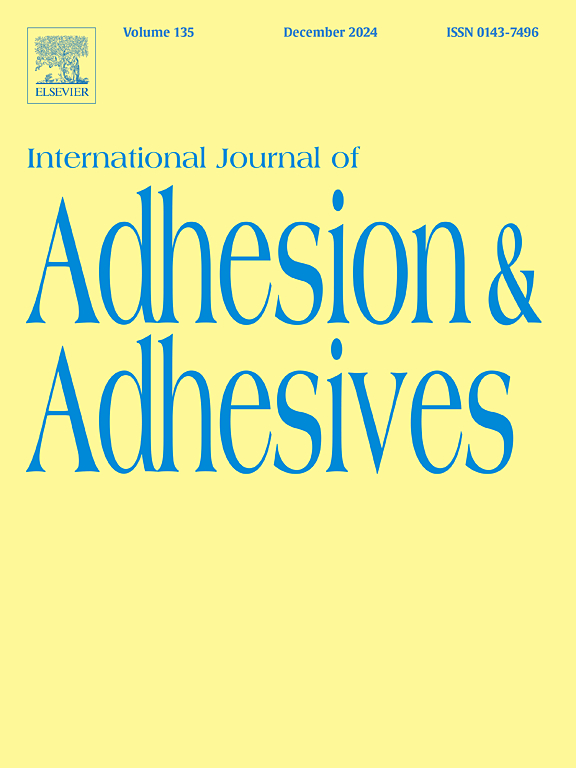A facile strategy for fabricating high-temperature soybean meal–based adhesive with reduced viscosity, prolonged open time, and improved water resistance
IF 3.2
3区 材料科学
Q2 ENGINEERING, CHEMICAL
International Journal of Adhesion and Adhesives
Pub Date : 2025-04-20
DOI:10.1016/j.ijadhadh.2025.104038
引用次数: 0
Abstract
Soybean-based adhesives fabricated from high-temperature soybean meal (HTSM) have a lower cost but significantly shorter open time and much higher viscosity than the commercial adhesives using low-temperature soybean meal (LTSM). This still limits their wide commercial applications. In this study, fresh soybean meal (FSM) was partially substituted for HTSM, effectively prolonging open time and reducing the viscosity of HTSM-based adhesive without compromising bonding performance. This improvement was mainly attributed to the synergistic interactions between undenatured soybean proteins and hydrophobic soybean oil (SO) present in FSM. Due to less water loss and fewer cross-linkages caused by heat-induced denaturation, the undenatured proteins can obviously reduce viscosity and prolong open time in HTSM-based adhesives. Additionally, the hydrophobic SO with its small molecular weight can inhibit water absorption by HTSM and act as a lubricant, thereby prolonging open time and reducing viscosity to some extent. The optimized HTSM-based adhesive, with 34.3 % FSM addition, exhibited a 91 % reduction in viscosity, an 89 % increase in open time, and a 17.6 % improvement in soaked wet strength (1.27 MPa). Therefore, adding FSM provides a facile strategy for effectively prolonging open time and reducing the viscosity of HTSM-based adhesives, making their performance comparable to commercial LTSM-based adhesives.
一种制备高温豆粕基胶粘剂的简便方法,具有降低粘度、延长打开时间和提高耐水性的特点
以高温豆粕(HTSM)为原料制备的大豆基胶粘剂与以低温豆粕(LTSM)为原料的商用胶粘剂相比,具有成本较低、打开时间短、粘度高的优点。这仍然限制了它们广泛的商业应用。本研究用新鲜豆粕(FSM)部分替代HTSM,在不影响粘接性能的前提下,有效延长HTSM基胶的开启时间,降低HTSM基胶的粘度。这种改善主要归因于FSM中存在的未变性大豆蛋白与疏水大豆油(SO)之间的协同相互作用。由于未变性蛋白的水分损失少,热变性引起的交联也少,因此在htsm基胶粘剂中,未变性蛋白能明显降低黏度,延长打开时间。此外,分子量小的疏水SO可以抑制HTSM的吸水,起到润滑剂的作用,从而在一定程度上延长打开时间,降低粘度。优化后的htsm基胶粘剂(FSM添加量为34.3%)粘度降低91%,打开时间增加89%,浸泡湿强度(1.27 MPa)提高17.6%。因此,添加FSM提供了一种简便的策略,可以有效地延长htsm基粘合剂的打开时间,降低其粘度,使其性能与商用ltsm基粘合剂相当。
本文章由计算机程序翻译,如有差异,请以英文原文为准。
求助全文
约1分钟内获得全文
求助全文
来源期刊

International Journal of Adhesion and Adhesives
工程技术-材料科学:综合
CiteScore
6.90
自引率
8.80%
发文量
200
审稿时长
8.3 months
期刊介绍:
The International Journal of Adhesion and Adhesives draws together the many aspects of the science and technology of adhesive materials, from fundamental research and development work to industrial applications. Subject areas covered include: interfacial interactions, surface chemistry, methods of testing, accumulation of test data on physical and mechanical properties, environmental effects, new adhesive materials, sealants, design of bonded joints, and manufacturing technology.
 求助内容:
求助内容: 应助结果提醒方式:
应助结果提醒方式:


